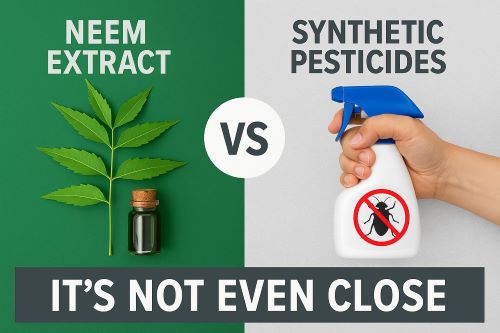


neem extract offers a natural, biodegradable, and multi-functional tool that aligns with integrated pest management (IPM) principles.
Neem extract, derived from the seeds of the neem tree (Azadirachta indica), contains a complex cocktail of over 100 biologically active compounds. The most studied among these is azadirachtin, known for disrupting insect moulting and reproduction.
Unlike synthetic pesticides, neem extract:
In our tomato and okra trials, a consistent 60–70% drop in whitefly and fruit borer populations was observed over two cropping cycles. A reliable field-grade option is the Dr Anand Neem 0.15% Bio Insecticide, which provides standardized azadirachtin levels suitable for intensive applications while remaining compatible with organic certification standards.
Synthetic pesticides, such as organophosphates, pyrethroids, and neonicotinoids, target pests’ nervous or respiratory systems, causing instant mortality. They are highly effective in short-term control but present several long-term challenges:
According to a 2021 report by Pesticide Action Network, over 25% of the world’s commonly used pesticides are classified as “highly hazardous.” These compounds have been linked to neurological disorders, hormonal disruptions, and biodiversity loss.
One of the most pressing problems with synthetic pesticides is resistance. Pests evolve quickly, rendering active ingredients ineffective within 5–10 years. The diamondback moth, for instance, has developed resistance to over 40 active compounds globally.
Neem extract, in contrast, affects multiple biological processes:
Because neem’s mode of action is multi-targeted and indirect, pests are less likely to adapt to it quickly. That’s why it’s considered a core element in resistance management programmes in regions where overuse of chemicals has backfired.
Concern over synthetic pesticide residues is developing, particularly regarding consumer health and food exports. Pesticide residues were found in more than 45% of tested fruits and vegetables, some of which had levels beyond permissible limits, according to the European Food Safety Authority (EFSA).
“When pest control aligns with ecological cycles, we stop treating nature as a threat—and start working with it.”
In one comparative trial between chemical pesticides and neem-based sprays on eggplant, the synthetic group required a 21-day pre-harvest interval due to residue concerns. In contrast, the neem-treated group could be harvested within 24–48 hours.
Integrated pest management (IPM) uses biological, mechanical, and chemical tools to keep pest populations below economic thresholds. Synthetic pesticides often disrupt IPM by eliminating natural predators, leading to pest resurgence.
Neem extract integrates seamlessly into IPM strategies by:
It’s also listed in multiple organic certification systems, including OMRI and Indian NPOP standards, making it a preferred choice for export-oriented farming.
|
Feature |
Synthetic Pesticides |
Neem Extract |
|
Speed of Action |
Instant |
Gradual but lasting |
|
Residue Risk |
High |
Very low |
|
Pest Resistance Potential |
High |
Low |
|
Pollinator Safety |
Low |
High |
|
Environmental Degradation |
Persistent residues |
Biodegradable |
|
Compatibility with IPM |
Often disruptive |
Highly compatible |
For commercial farmers dealing with export standards or local farmers prioritizing soil health, neem extract offers a reliable, eco-safe, and residue-free option.
Neem extract and other bio-based remedies are becoming increasingly popular worldwide as climatic instability rises and chemical regulations tighten. They represent an advancement in ecological intelligence rather than a compromise.
